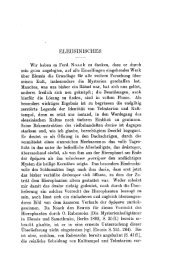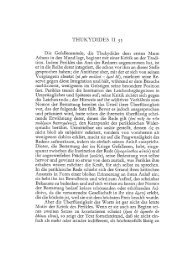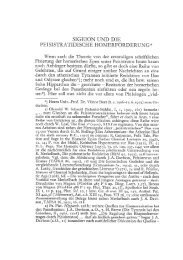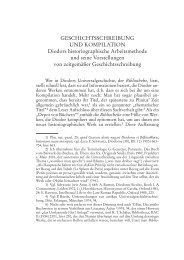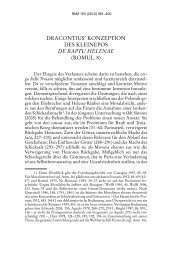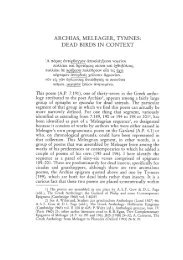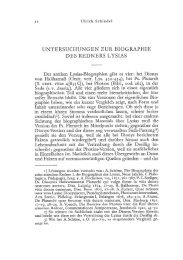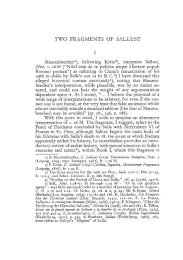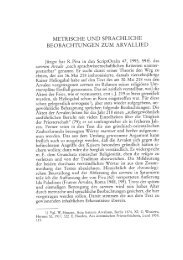APOTELESMATICA 2. (1) 14–140: SOURCES AND MODELS*
APOTELESMATICA 2. (1) 14–140: SOURCES AND MODELS*
APOTELESMATICA 2. (1) 14–140: SOURCES AND MODELS*
Create successful ePaper yourself
Turn your PDF publications into a flip-book with our unique Google optimized e-Paper software.
94 Maria Ypsilanti<br />
Other literary echoes: Homer, Hesiod, Apollonius, Manilius<br />
The epic style of Pseudo-Manetho’s work invites reference to<br />
old epic and indeed encompasses echoes mainly from Homer and<br />
Hesiod creatively exploited and adjusted in the new context. It<br />
would be sufficient here to refer to certain characteristic cases, including<br />
adaptations and variations of epic formulas. Such is fËla<br />
brot«n (l. 16), a variation of the epic fËlÉ ényr≈pvn. 61 F¤low,<br />
again, an adjective commonly used in epic formulas, freely combined<br />
with various nouns in a sense equivalent to the possessive<br />
pronoun, ‘my’, ‘your’ (patr¤w ga›a, yumÒw, uflÒw, êloxow, etc.);<br />
Pseudo-Manetho attaches it to éoidÆ (l. 17) to indicate his own<br />
poetry, attaching thus his work, from the opening section, to the<br />
didactic tradition, as it is exactly this genre, described as éoidÆ, that<br />
the Muses taught Hesiod, according to his own testimony. 62<br />
Katå kÒsmon (l. 15) is an epic expression meaning ‘properly’,<br />
‘in a becoming way’, ‘in order’. 63 If we place the phrase in an adjunct<br />
with the “signs” (ka‹ de¤khlÉ), as Koechly does, we are obliged<br />
either to connect two terms not syntactically equal and have another<br />
katã meant (“in neat order and through the signs”), which<br />
would result to an impossible construction, or take kÒsmow to mean<br />
‘world’ and translate “through the world and the signs”, which is<br />
unlikely after diå kÊklou ZvdiakoË, especially when émeibÒmenoi<br />
invites the adverbial sense of katå kÒsmon = “in order”. Given that<br />
G most probably transmits the manuscript’s reading, 64 the nonsense<br />
AÉ d¤khlÉ of the codex could be corrected to éllÆktvw 65 or<br />
61) Od. 3.282, 7.307, 15.409, h. Apol. 161, al., Hes. fr. 1,1.<br />
62) Th. 22 a· nÊ poyÉ ÑHs¤odon kalØn §d¤dajan éoidÆn. Cf. also Hes. Th. 31<br />
§n°pneusan d° moi éoidÆn, if this variant, instead of the vulgate reading aÈdÆn, is<br />
correct, see West ad loc. ÉAe¤dein has become common in expressions of self-referentiality<br />
in poetry, and poets do speak of their work in the first person with this<br />
verb, cf. for instance Theogn. 4, Pind. N. 5.50, N. 10.31. Callimachus often uses the<br />
verb, especially in pieces of programmatic importance: frr. 1.33 drÒson ∂n m¢n<br />
ée¤dv, 61<strong>2.</strong>1 émãrturon oÈd¢n ée¤dv, H. <strong>2.</strong>106; cf. H. 1.1, ibid. 92, H. <strong>2.</strong>31.<br />
63) Il. <strong>2.</strong>214, 8.12, 10.472, 11.48, al.<br />
64) “Gronovius summa fide codicem descripsit” (Koechly 1851, iii). “Hunc<br />
poetam summa cum cura primum ex MS bibliothecae Mediceae manu mea descripsi,<br />
deinde numerum versuum ad MS exegi”, according to Gronovius himself (Praefatio<br />
4).<br />
65) The poet uses êllhkta (3. [2] 206) and êllhkton (3. [2] 252) also as adjectives.



